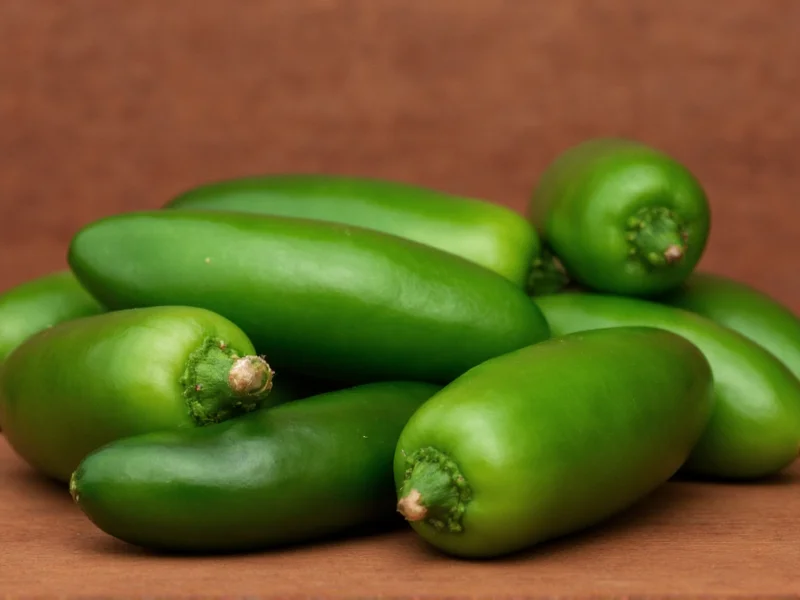When comparing jalapeno vs serrano heat levels, the difference is substantial enough to impact recipe outcomes significantly. Understanding this chili pepper heat comparison helps home cooks and culinary professionals make informed decisions when selecting peppers for their dishes.
Understanding Pepper Heat Measurement
Pepper heat is scientifically measured using the Scoville Scale, which quantifies capsaicin concentration—the compound responsible for spiciness. Developed by Wilbur Scoville in 1912, this scale remains the standard reference for comparing chili pepper spiciness levels. Modern testing uses high-performance liquid chromatography for precise measurements, but results are still expressed in Scoville Heat Units for consistency.
Jalapeño Pepper Profile
Jalapeños, one of the most widely recognized chili peppers globally, offer a moderate heat experience that makes them accessible to most palates. Their heat range spans from mild to moderately hot:
| Pepper Characteristic | Jalapeño Measurement |
|---|---|
| Scoville Heat Units (SHU) | 2,500-8,000 |
| Average Heat Level | Moderate |
| Flavor Profile | Grassy, bright, with subtle fruitiness |
| Common Culinary Uses | Salsas, nachos, poppers, pickled preparations |
Factors like growing conditions, maturity, and even specific plant genetics cause natural variation in jalapeno heat level compared to serrano. Black jalapeños (fully matured) typically register at the higher end of the heat spectrum, while lighter green varieties tend to be milder.
Serrano Pepper Profile
Serrano peppers, though smaller than jalapeños, pack a considerably more potent punch. Native to Mexico's mountainous regions (sierras, hence the name), these peppers deliver consistent heat with distinctive flavor characteristics:
| Pepper Characteristic | Serrano Measurement |
|---|---|
| Scoville Heat Units (SHU) | 10,000-23,000 |
| Average Heat Level | Hot to very hot |
| Flavor Profile | Grassy, bright, with citrus notes |
| Common Culinary Uses | Pico de gallo, hot sauces, salsas verdes, marinades |
The serrano pepper Scoville scale rating places it solidly in the hot category, making it unsuitable for those sensitive to spice. Unlike jalapeños, serranos maintain consistent heat throughout their color variations, whether green, red, orange, or yellow.
Direct Heat Comparison: Jalapeño vs Serrano
When conducting a jalapeno vs serrano heat comparison, the difference becomes immediately apparent. The mildest possible serrano (10,000 SHU) still exceeds the hottest possible jalapeño (8,000 SHU). On average, serranos deliver approximately 2-4 times more capsaicin than jalapeños.
This heat differential significantly impacts cooking applications. While jalapeños provide noticeable warmth without overwhelming other flavors, serranos command attention in dishes. The how much hotter are serranos than jalapeños question has practical implications for recipe development and substitution.
Practical Cooking Implications
Understanding the why are serrano peppers hotter than jalapenos distinction helps in recipe planning. The higher capsaicin concentration in serranos means:
- You need fewer serranos to achieve equivalent heat levels
- Serranos can overpower delicate flavors if used in equal quantities
- Seeds and membranes contain the highest concentration of capsaicin in both varieties
- Cooking time affects heat perception—longer cooking releases more capsaicin
When substituting serrano for jalapeno in recipes, use approximately one-third to one-half the amount of serranos to maintain similar heat levels. For example, if a recipe calls for two jalapeños, use one serrano pepper for comparable spiciness.
Growing Conditions and Heat Variation
Environmental factors significantly influence the actual heat experienced with both peppers. Stressors like water scarcity, temperature extremes, and soil conditions cause plants to produce more capsaicin as a defense mechanism. This explains why jalapeno heat level compared to serrano can vary between harvests.
Commercial growers often optimize conditions to produce milder peppers for broader market appeal, while artisanal growers might encourage stress conditions to maximize heat for specialty markets. This variability means that even within the same variety, heat levels can differ substantially.
Common Misconceptions
Several myths persist about these popular peppers:
- Myth: Red jalapeños are always hotter than green ones Reality: Color indicates maturity, not necessarily heat level
- Myth: Larger peppers are milder Reality: Size correlates with growing conditions, not heat
- Myth: Removing seeds eliminates all heat Reality: While seeds contain concentrated capsaicin, the surrounding placenta holds most heat
- Myth: Serranos and jalapeños are interchangeable in equal quantities Reality: This substitution typically creates an unexpectedly spicy dish
Understanding these facts helps prevent culinary mishaps when working with cooking with serrano peppers instead of jalapenos.
Final Considerations for Home Cooks
When deciding between these peppers, consider both heat preferences and flavor profiles. Jalapeños offer approachable warmth with versatile flavor, while serranos deliver pronounced heat with distinctive citrus notes. For those exploring jalapeno vs serrano heat levels, starting with jalapeños and gradually incorporating serranos allows for developing heat tolerance while expanding culinary repertoire.











 浙公网安备
33010002000092号
浙公网安备
33010002000092号 浙B2-20120091-4
浙B2-20120091-4